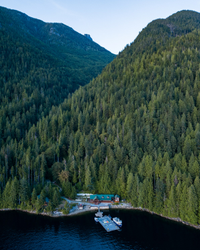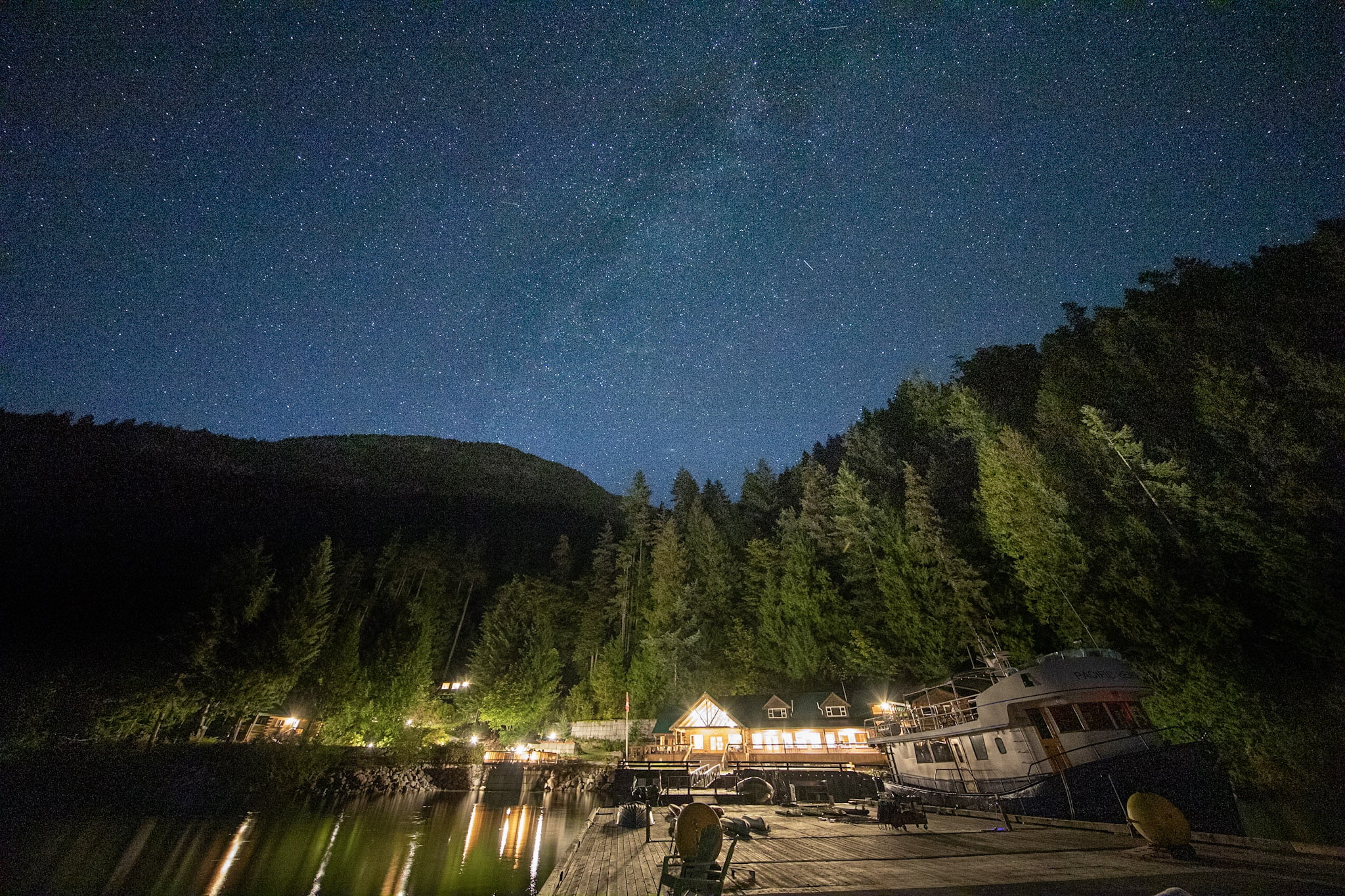At the Indigenous-owned Klahoose Wilderness Resort off British Columbia’s Desolation Sound, I got close enough to hulking grizzly bears to be able to count their claws as they dismantled and devoured dozens of salmon.
I also learned about the culture and history of the Klahoose people and their neighbours from a group of Indigenous guides who soon felt like friends, making this nature-focused adventure even more fulfilling.
 Tom Parker
Tom Parker
Canadians say they’re seeking meaningful travel experiences in 2022 as pandemic restrictions ease. This isolated off-grid, luxury eco-resort fulfills that wish, with a culturally rich and outdoor-focused experience in a pristine place of powerful natural beauty. “People are looking for that connection,” said the resort’s tourism manager Chris Tait.
The tragic discovery of hundreds of unmarked graves at former residential schools has many Canadians wondering how they can learn about and show support for Indigenous people. Tourism can be an act of reconciliation, said Klahoose Chief Kevin Peacey, who visited the lodge during my stay.
 Klahoose Wilderness Resort
Klahoose Wilderness Resort
“I want (visitors) to take the beautiful territory that we have away with them, the territory that we look after,” he said. “I’d like to see them have a look at our culture and believe in our culture and have that experience.”
To get to the resort, eight of us boarded a small boat for the one-hour ride from Lund on the northern end of the Sunshine Coast. Typically, 12 to 24 guests are accommodated by the property’s four rooms and three cabins.
Cultural ambassador and carver Klemqwateki “Randy” Louie of the Quw’utsun and Klahoose Nations welcomed us to the lodge and the traditional territory of the Klahoose First Nation with singing and drumming. Louie translated the words of the greeting song: “It’s good to see you. Come ashore. Stay a while.” Tom Parker
Tom Parker
The former Homfray Lodge was purchased by the Klahoose Nation’s business arm in late 2020 and re-opened in May 2021 as Klahoose Wilderness Resort, with three and four-night, all-inclusive stays. The property reflects Indigenous values of land stewardship. Recent updates to the hydroelectric system eliminated the need for backup diesel power, eliminating 38 tonnes of yearly carbon emissions. The resort also has a drinking water purification system.
From May to late August, guests boat to Toba Inlet with Indigenous guides to watch for orcas and humpback whales, dolphins, Dall’s porpoises, eagles, harbour seals and sea lions aboard the resort’s new 12-seat catamaran, Goat 1. It’s named for the mountain goat, an animal important to the Klahoose people because its long hair can be woven for clothing and regalia.

 Klahoose Wilderness Resort
Klahoose Wilderness Resort
Excursions include a close-up view of a towering waterfall tumbling down a mountainside and into the channel. In late spring and summer, the boat pulls in close to tidal estuaries on shore, excellent places to watch grizzlies digging up shellfish.
Back at the resort, there’s kayaking, stand-up paddleboards and rainforest trails for easy hikes, including one which finishes at a rocky point that provides excellent views of the lodge.
 Klahoose Wilderness Resort
Klahoose Wilderness Resort
Meals are served in a dining room off the sprawling cedar great room. We’d often gather here by the fire to have a coffee or chat with Louie about his work as a carver. He made the cedar paddles on display in the lodge and in all of the guest rooms, alongside textiles with patterns by Coast Salish artist Simone Diamond. For those of us unable to fully immerse ourselves in off-grid life, it was also the only place on the property with Wi-Fi.
In late August, the salmon spawn signals the start of grizzly viewing, which continues until the resort closes for the season in October. Two days of bear watching is included in fall stays.
“In our culture, to see an eagle first thing in the morning [means] you’re going to have a good day,” said boat skipper and bear guide Leon Timothy as we sailed towards Toba Inlet on our first day of grizzly watching. He was right. We saw so many bears that day, how could we feel anything other than lucky?
Cheyanne Hackett, an experienced grizzly bear guide from the neighbouring Homalco First Nation, met us at the dock. She wore a woven cedar hat and a bright-red button blanket sewn by her grandmother and drummed and sang the Women’s Warrior Song in her language to welcome us and honour missing and murdered Indigenous women and girls.
A small bus took us to elevated wooden viewing towers along the shore of a shallow river as Hackett told us about bear research and behaviors, and explained the unique relationship her people have with the grizzlies. Her cousin, who is also a guide, told her their ancestors live inside the grizzly bears.
 Klahoose Wilderness Resort
Klahoose Wilderness Resort

“It’s not a zoo,” Hackett reminded us. The bears are in their home. We watched them fish, eat and laze in the shallows, quickly learning that the quieter we were, the longer the bears would stick around.
We returned to the lodge thrilled with the day.
Later, weaver Anita Noble, who made the traditional cedar hats on display in the lodge’s great room, showed us how to twist cedar bark strips into a rose. She explained how she harvests sacred cedar bark as West Coast First Nations people have for millennia, peeling a long, narrow strip of bark without harming the tree. She thanks the tree with words and a tobacco offering.
 Darren Hull
Darren Hull
After a dinner of roasted halibut, I went out on the boat to help lodge kitchen staff pull up a prawn trap and found out what fresh sidestripe shrimp sashimi tastes like.
As Tait pointed out, while we’re learning on this trip, it’s a pretty fun way to do it. “It’s what travel should be,” he said.
That night, the sky was filled with stars. I fell asleep to the sound of snuffling harbour seals settling in on the large lodge dock. They were still there when we went down for morning yoga before breakfast. The coffee was on, there was a fire crackling in the lodge woodstove and the water was like glass reflecting the tree covered mountains around us in the early light.
When you go Regan Hatley
Regan Hatley
Klahoose Wilderness Resort is a boat-in, all-inclusive, off-grid eco-lodge with four rooms and three cabins.
There is Wi-Fi in the great room of the main lodge but not in-suite.
Families are welcome (children under two years old are free), however, the minimum age to participate in Grizzly Bear Viewing Tours is 10 years old, due to the two-to-three-hour duration of quiet wildlife observation.
Getting there
 Tom Parker
Tom Parker
Boat transportation to and from Lund to the resort is included in the all-inclusive price.
Transfers between Powell River Airport and Lund are included for arrivals and departures on Pacific Coastal Airlines from Vancouver South Terminal to Powell River.
Guests on Harbour Air seaplanes from Coal Harbour to Powell Lake can arrange a taxi to Lund or stay overnight in Powell River and take the free shuttle the following day.
2022 Rates
Rates start at $2,395 per person from May 12 to June; $2,595 per person for July and August and $2,895 per person for grizzly bear-watching season Aug. 25 to Oct. 13. Four-night stays are available. Booking for 2023 is also open. Optional tours such as guided fishing charters are extra.
For more information visit klahooseresort.com
Editor’s note: Linda Barnard’s trip was hosted by Destination British Columbia. All opinions are her own and Destination British Columbia did not preview this story prior to publish.



